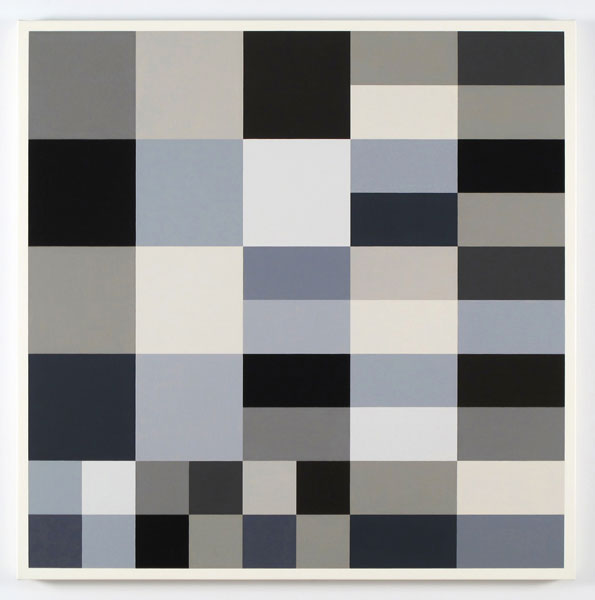
December 18, 2014

Cary Smith, “Grey Blocks #21,” 2012. Oil on linen, 31 × 31"

Don Voisine, “Contact,” 2014. Oil on wood panel, 17 × 17"
CARY SMITH and DON VOISINE: Orthogonal and Diagonal
Gregory Lind Gallery, San Francisco
November 6 – December 20, 2014
Interspersed in a two-person show in San Francisco, the work of Cary Smith and Don Voisine is heavy on black and white, with notes of color punctuating in concert and alone. Both Smith and Voisine are working out of a tradition of geometric abstraction that is again enjoying a moment in the spotlight. For seasoned viewers, the cyclical nature of what we are given to look at in any particular time is familiar. Yet the meanderings of geometric thought that have been with us since the beginning, from the earliest remains of potsherds in the anthropology museum to the present day, go much deeper. From notations incised in clay to the genre of the hard-edge, there are consistencies in the problematics of fixity and fluidity.
This historical context sheds light on the importance of both Voisine and Smith’s desire to keep things in motion. While the hard-edge appears to be fixed, the organization of elements in both their work sets things in motion. Hung with an eye to these relationships, their works reach across the room to extend the conversation.
Voisine is especially known for his black-on-black paintings, with their subtle shifts in surface reflectivity ranging from chalky matte to high gloss that allows neighboring forms to be distinguished by the sheen of their skin. He often uses specific but simple diagonally oriented shapes that are overlaid to generate forms. The complexity of the resulting configurations is unexpected because his project initially appears to be so simple in and of itself. Soon enough it becomes apparent that only a finely honed internal logic could generate the kind of minimal diagonals, in “Noir” (2014) for example, that torque the central expansive “X” form and allow it to take on volume.
Cary Smith’s Grey Blocks (2012 – 14) paintings are configured on a grid whose demarcations often vary from the upper left to the lower right corner on a kind of diagonal symmetry. Modulated in warm gray, blue gray, charcoal, and black tones they set in motion the painting’s subtle changes in value. These orthogonal forms don’t rest—they are shifting and slide forward as they claim relationships and generate connectivity, momentarily though, before giving way to the next most demanding articulation. Like an LED screen or video monitor, their unceasing motion can be mesmerizing, yet the kind of movement they create is different, allowing for an opening up of thoughts and contemplation of relations.
There is a calm cohesive feel to the show, the correspondences between Voisine and Smith redolent. Voisine’s “Time Piece” (2014) and “Index” (2014) both use a series of rectangles around their central black-on-black squares that spin around the frame while the high-contrast moments pop. Next to it, the bright canvas ground and multicolored grid of squares in Smith’s “Yellow Wonder Wheel #1” (2014) begin to fluctuate, making the regularity of the grid dissolve. Smith’s movement evolves slowly as we key in initially with the contrasts and then, as time is taken, colors register and start the boogie.
Smith, initially known for his exquisitely and precisely painted stripes, has several different formats in the show. Two small pieces at the entrance are mostly comprised of striped black and white and gray forms, both warm and cool, but then in the corner they break with the logic they start to suggest and begin to pixelate. There are several common terms that come to mind here—one is veils, the other is passes. Often in Voisine’s work there are geometric shapes positioned side-by-side that are equivalent; then a layer is laid down passing over the top of them to “connect” the two forms. In “Hinge” (2014), this veil sets the work in motion, the left side tends upwards and the right side downwards. Banded by two gray horizontal stripes, the movement perpetuates.
Smith’s use of motion in the Grey Blocks series tends to move forward and back of the picture plane, and while some works like “Grey Blocks #21” (2012) are calmer, next to it are more active renditions. The subtle variation in both the temperature and value of the grays makes it seem as if, like in the Voisines, there are layers of color put down on top of each other. The net effect of this illusion is to enhance relationships between the singular rectangles. And while this is all pretty subtle, the motion and tension that the value changes generate becomes all the more pronounced in the company of Voisine.
There is a lot of humor in both artists’ work and it’s a relief to feel that neither takes himself too seriously. The days of purist geometry and the tyranny of quietude seem far away. In Voisine’s “Herald,” a crest-like form is an arrow pointing south. Smith’s Splat series reads like the hallmark of hybridity. One could infer from this or not, but to read between the lines is an interpreter’s pleasure.